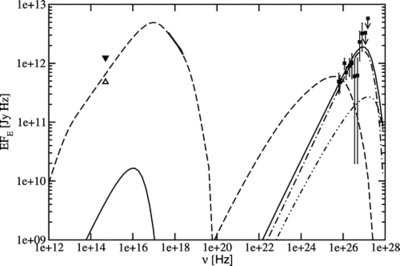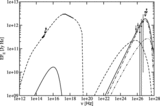Image Details

Caption: Fig. 1.
Simultaneous optical–X‐ray–VHE γ‐ray SED of 1ES 1101−232 on 2005 March 5–16 (from Aharonian et al. 2007a). The VHE measurements have been corrected for absorption by the IIBR, as described in Aharonian et al. (2006). The optical data points are an upper and a lower R‐band limit, respectively, derived from simultaneous ROTSE 3c observations in the 400–900 nm bandpass (Aharonian et al. 2007a). The curves indicate a model fit using an extended version of the code of Böttcher & Chiang (2002). The H.E.S.S. data have been fitted with ﹩\Gamma =15﹩, ﹩B^{\prime }=10﹩ μG, ﹩\gamma ^{\,\prime }_{1}=100﹩, ﹩\gamma ^{\,\prime }_{2}=6.0\times 10^{6}﹩, ﹩q=1.5﹩, and ﹩L_{\mathrm{jet}\,}=1.5\times 10^{41}﹩ ergs s−1. The individual curves represent CMB Compton emission (dot‐dashed curve), SSC emission (double‐dot–dashed curve), and total emission (solid curve) from the VHE‐emitting region. The dashed curve, fitting the synchrotron component, has been computed with parameters more appropriate to the inner‐jet region, with ﹩\Gamma =25﹩, ﹩\gamma ^{\,\prime }_{1}=1.3\times 10^{5}﹩, ﹩\gamma ^{\,\prime }_{2}=7.5\times 10^{5}﹩, ﹩q=3.2﹩, ﹩L_{\mathrm{jet}\,}=2.0\times 10^{40}﹩ ergs s−1, and ﹩R^{\,\prime }_{B}=6\times 10^{16}﹩ cm, and a magnetic field in equipartition with the relativistic electron plasma, at ﹩B^{\,\prime }=0.06﹩ G. The X‐ray/γ‐ray portion of the dashed curve represents the inner‐jet SSC emission.
Copyright and Terms & Conditions
© 2008. The American Astronomical Society. All rights reserved. Printed in U.S.A.




